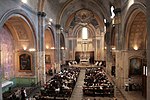Canton of Orange-Ouest
2015 disestablishments in FranceFormer cantons of VaucluseStates and territories disestablished in 2015Vaucluse geography stubs

The canton of Orange-Ouest is a French former administrative division in the department of Vaucluse and region Provence-Alpes-Côte d'Azur. It had 24,579 inhabitants (2012). It was disbanded following the French canton reorganisation which came into effect in March 2015.
Excerpt from the Wikipedia article Canton of Orange-Ouest (License: CC BY-SA 3.0, Authors, Images).Canton of Orange-Ouest
La Languedocienne, Carpentras
Geographical coordinates (GPS) Address Nearby Places Show on map
Geographical coordinates (GPS)
| Latitude | Longitude |
|---|---|
| N 44.119444444444 ° | E 4.7902777777778 ° |
Address
La Languedocienne
84100 Carpentras, Costa
Provence-Alpes-Côte d'Azur, France
Open on Google Maps










